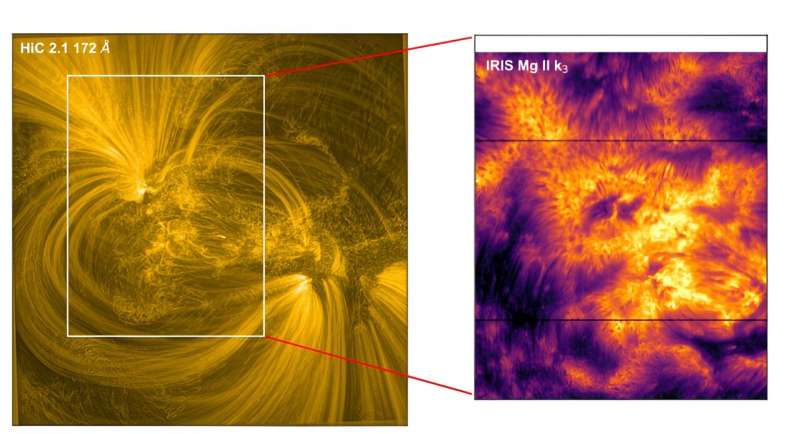
Did you know the sun has moss? Due to its resemblance to the earthly plants, scientists have named a small-scale, bright, patchy structure made of plasma in the solar atmosphere “moss.” This moss, which was first identified in 1999 by NASA’s TRACE mission, blossoms around the center of a sunspot group, where magnetic conditions are strong. It straddles two atmospheric layers known as the chromosphere and corona and hides below the long feathery ropes of plasma known as coronal loops.
For decades, scientists have struggled to understand how this mossy region is connected to the sun’s lower atmospheric layers and how material there is heated from 10,000 degrees Fahrenheit up to nearly 1 million degrees Fahrenheit—100 times hotter than the bright surface just below.
Now, research enabled by NASA’s High Resolution Coronal Imager (Hi-C) sounding rocket and NASA’s Interface Region Imaging Spectrograph (IRIS) mission have given scientists insights into the superheating mechanism at play in the moss.
Observations from these instruments combined with complex 3D simulations have now revealed that electrical currents may contribute to heating the moss. Throughout this region there is a mess of magnetic field lines, like invisible spaghetti. This tangle of magnetic spaghetti creates electrical currents that can help heat material to a wide range of temperatures from 10,000 to 1 million degrees Fahrenheit.
This local heating in the moss appears to occur in addition to heat flowing from the hot, multi-million-degree overlying corona. This insight, published in the journal Nature Astronomy on April 15, can help scientists understand the larger question of why the sun’s entire corona is so much hotter than the surface.
“Thanks to the high-resolution observations and our advanced numerical simulations, we’re able to figure out part of this mystery that’s stumped us for the past quarter of a century,” said author Souvik Bose, a research scientist at Lockheed Martin Solar and Astrophysics Laboratory and Bay Area Environmental Institute, NASA’s Ames Research Center in California’s Silicon Valley. “However, this is just a piece of the puzzle; it doesn’t solve the whole problem.”
For that, many more observations are needed. Some are coming soon: Hi-C is scheduled to launch again this month to capture a solar flare, and it may also capture another moss region together with IRIS. However, to obtain observations that can fully address how the corona and moss are heated, scientists and engineers are working to develop new instruments onboard the future MUlti-slit Solar Explorer (MUSE) mission.
More information:
Souvik Bose et al, Chromospheric and coronal heating in an active region plage by dissipation of currents from braiding, Nature Astronomy (2024). DOI: 10.1038/s41550-024-02241-8
Journal information:Nature Astronomy
Provided by
NASA

READ MORE
Eels Are Victims of Noise Pollution
A critically endangered European eel. Photo: Fabio Pupin/Visuals Unlimited/Corbis Noise pollution isn’t just a problem [...]
10 Types of Body Butter
What’s a dry-skinned person to do when faced with tough choices in the moisturizer department? [...]
Nanoparticle delivery of FZD4 to lung endothelial cells inhibits lung cancer progression and metastases
Credit: EMBO Molecular Medicine (2024). DOI: 10.1038/s44321-024-00064-8 A recent study from the lab of Tanya [...]
6 Real-Life Man-Eating Animals
© Daleen Loest/Shutterstock.com Humans may be this planet’s dominant species, but our superior intellect doesn’t [...]
Coral Snakes: Brightly Banded and Highly Venomous
The eastern coral snake (Micrurus fulvius) is highly venomous and lives in a variety of [...]
Pimento Cheese: The Southern Staple With Northern Roots
The $1.50 pimento cheese sandwiches sold at the Masters are nearly as famous as the [...]
A Hypochondriac Knows Those ‘Germs’ That Threaten Him Are Real
Wikimedia Commons Like many of life’s problems, this one began in my childhood, roughly between [...]
Arsenic and Old Graves: Civil War-Era Cemeteries May Be Leaking Toxins
Live near a cemetery? Better check your drinking water. The Brett Weston Archive/CORBIS If you [...]